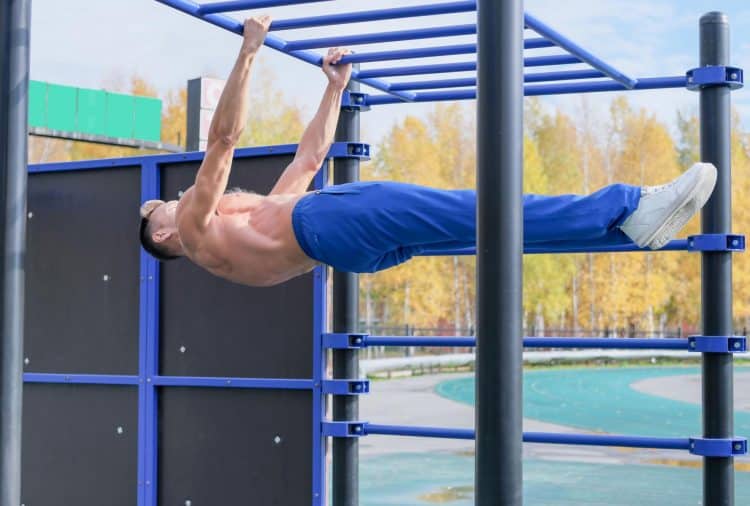The front lever is a foundation exercise in gymnastics and calisthenics. It is one of the three lever exercises in calisthenics, including the back lever and planche. The front lever is rated A in the gymnastic code of points — a scale from A to F, where F is the hardest.
A correctly done front lever makes you look like you’re lying flat in the air. Your extended arms make you look like a floating mummy.
The front lever demands core and upper body strength to perform correctly. Contrary to what most exercisers believe, the front lever is more difficult than the back lever. Although the back lever requires you to be upside down and have your arms behind your back, this position helps stabilize your lats and results in chest and shoulder recruitment, which helps make the exercise easier by reducing the tension on your abs.
In the front lever, you have to maintain your body in a straight line from head to toe and parallel to the floor using your abs and lats. Your body weight and height also play a role in the front lever. Taller and heavier individuals will find it harder to perform the front lever than their shorter and lighter counterparts.
This article covers the correct form of performing the front lever. We also cover the benefits, progression, and expert tips to make the most of this gymnastics exercise. Take notes of the common mistakes and avoid emulating them in your training.
What is a Front Lever?

The front lever is an advanced bodyweight calisthenics exercise involving suspending your body horizontally while holding onto a pull-up bar or rings. Your body remains straight while your arms are extended, and your shoulder blades are pulled down and back.
Level Up Your Fitness: Join our 💪 strong community in Fitness Volt Newsletter. Get daily inspiration, expert-backed workouts, nutrition tips, the latest in strength sports, and the support you need to reach your goals. Subscribe for free!
The front lever primarily targets the core, back, and shoulders. You need significant upper body and core strength to hold this exercise. Beginners must start with progression exercises and build toward the front lever. The front lever progression exercises will include a mix of core and back exercises.
Muscles Worked During Front Lever
Here are the muscles targeted in the front lever:
Latissimus dorsi
Lats are the biggest muscle in your back. The lats help pull up your upper body and maintain a horizontal position while performing the front lever. Since your lats are not locked while performing the front lever, like in the case of the back lever, you have to focus on actively contracting your back so it is parallel to the floor throughout the exercise.
Teres major
It helps the lats extend and adduct the arm. Teres major enables you to maintain the horizontal position during the front lever. You must actively contract your back throughout the exercise for optimal teres major stimulation.
Posterior deltoids
Since the front lever involves extending your arms in front of your body and keeping your body parallel to the floor, you will experience a noticeable rear delt engagement in the front lever.
Lower trapezius
Lower traps are located in the middle and lower back and help stabilize and rotate the shoulder blades. These muscles help keep your shoulders pulled back and down during the front lever.
Erector spinae
These muscles run along the spine and help spine extension and rotation. You’ll engage the erector spinae to keep your body horizontal throughout the exercise.
Core
The rectus abdominis is the “six-pack” muscle. It holds your internal organs in place and keeps your body stable during movement. The rectus abdominis also enables trunk flexion and compressing of the abdomen. It keeps your midriff horizontal. Your obliques are also recruited during the lift and prevent midsection rotation during the static hold.
Glutes
Bracing your glutes during the lift will help stabilize your core and body during the exercise and help keep your body parallel to the floor.
Forearms
The front lever requires a strong grip. You’ll experience significant forearm stimulation during the exercise. Use a thumbless (thumbs around the bar) grip to reduce the stress on your forearms.
Benefits of Front Lever
Adding the front lever to your training regimen entails the following benefits:
Builds Upper Body and Core Strength
The front lever demands significant upper body and core strength. This exercise builds upper body, core strength, and stability, which can carry over to other functional exercises.
Better Posture
This exercise requires you to pull your shoulders back and down and push out your chest, which can improve your posture. The front lever can also reduce your risk of developing back pain due to poor posture.
Improved Coordination
You must pull down on the bar using your lats while raising your legs and contracting your core and glutes to execute the front lever. This multifaceted exercise can help improve your mind-muscle connection and coordination, enhancing your performance in other compound exercises and daily activities.
Performing the front lever on gymnastics rings demands more coordination than on a sturdy pull-up bar. Alternate between the two to add variety to your training routine.
How To Do Front Lever
The front lever might look easy, but you’ll realize the complexity of the exercise as soon as you try to get into the static hold.
Steps:
- Grab a pull-up bar with a shoulder-wide overhand (palms facing forward) grip.
- Your body should be in a straight line and perpendicular to the floor at the start position.
- Brace your core, back, shoulders, chest, and glutes, and pull your legs and hips up while leaning back.
- Your legs should be together throughout the exercise.
- Keep your body from head to toe in a straight line.
- Pull down on the bar as if performing a straight-arm cable lat pulldown. Your arms should be at a 70-degree angle with the floor at the static hold.
- Your body should be parallel to the floor from head to toe at the static hold.
- Hold the position for as long as possible.
- Slowly return to the starting position.
Pro Tips:
- Keep your head neutral throughout the exercise. Bending your head backward or tucking in your chin can strain your neck.
- Beginners should start performing this exercise on the pull-up bar as exercise rings add instability.
- Some exercises bend their elbows during the static hold. It makes holding the position at the top difficult.
- You could hold the position for as long as possible or do the exercise for reps. Beginners should stick with holding the position for time as it will help them master the form.
- You should work up to the front lever. Performing this calisthenics exercise from scratch is a monumental task. Use the progression exercises mentioned below to master the front lever.
This Exercise:
- Target Muscle Group: Core
- Secondary Muscles: Shoulders, Back, Arms, and Glutes
- Type: Isometric
- Equipment: Bodyweight, Pull-up bar
- Difficulty: Intermediate
- Best Rep Range: 1-10 second hold
Common Mistakes While Performing Front Lever
Stay clear of these front lever form errors:
Not Pulling Down on the Bar
You must engage your scapula and back to pull down on the bar. Failing to elevate your upper body will keep your arms directly below the bar, making the static hold more difficult.
Locking your arms at an angle pulls your hips under the bar, providing a better center of gravity and allowing you to maintain your body in a straight line from head to toe. Having your shoulders under the bar will require greater core engagement, and you will only be able to hold the position for a short time.
Arching Your Back
Many exercises arch their back or bend their legs or arms while doing this exercise. Your limbs should be extended and your torso flat and parallel to the floor. Bending your legs or back can put unnecessary strain on your lower back and neck, increasing your risk of injury.
Poor Core Engagement
You must brace your core and squeeze your glutes during the exercise to produce core and upper body strength. Failing to engage your core will lead to the sagging of your lower back and the inability to hold your legs parallel to the floor.
Not Using a Progression
Many trainers make the mistake of attempting the front lever without investing in learning the correct technique and improving their core and upper body strength. Doing progression exercises like the tuck lever and advanced tuck lever can improve your form, which can help you transition to the full front lever and lower your risk of injury.
Front Lever Progression
Given below is a five-step front lever progression:
1. Tuck Front Lever
The tucked front lever is the first progression exercise for this calisthenics skill.
Steps:
- Grab the bar with a shoulder-width overhand grip.
- Pull your knees and hips as close as possible to your chest by folding your legs and leaning back.
- Round your back and tuck in your knees.
- Your back should be almost parallel to the floor at the static contraction.
- Hold for as long as possible.
Pro Tip: Keep your arms straight and pull on the bar as you lean back.
Level Up Your Fitness: Join our 💪 strong community in Fitness Volt Newsletter. Get daily inspiration, expert-backed workouts, nutrition tips, the latest in strength sports, and the support you need to reach your goals. Subscribe for free!
2. Advanced Tuck Front Lever
Although the advanced tuck front lever is a minor variation of the tuck front lever, it puts significantly more tension on your core.
Steps:
- Get in the tuck front lever position using the steps mentioned above.
- Straighten your back, so it is almost parallel to the floor.
- Retract your shoulder blades and push out your chest.
- Extend your legs slightly, so your thighs are perpendicular to your body.
- Your heels should be next to your hips.
- Hold for as long as possible.
Pro Tip: Maintain a neutral head to avoid unnecessary stress on your neck.
3. One-Leg Front Lever
In this progression exercise, we begin extending our legs. Be prepared to feel significant tension in your abs.
Steps:
- Start in a tuck front lever position.
- Extend your back parallel to the floor, and push out your chest.
- Extend your right leg while keeping your left leg close to your chest.
- Your head, back, and right leg should be in a straight line at the static hold.
- Hold for the recommended time.
- Return to starting position.
- Get into the tuck front lever position.
- Repeat on your left leg.
- Alternate between sides for recommended reps.
Pro Tip: Turning your hands outward will help with better scapula engagement, which can aid in keeping yourself horizontal for longer.
4. Advanced One-Leg Front Lever
This exercise is a one-leg front lever variation that puts more tension on your midsection.
Steps:
- Get into the one-leg front lever position with your right leg extended and left held close to your chest.
- Slightly extend your left leg, so the upper leg is perpendicular to the floor.
- Hold the position for as long as possible.
- Alternate between sides for the recommended reps.
Pro Tip: Your legs should be close to each other, and the foot of the folded leg should be next to the extended knee.
5. Straddle Front Lever
The straddle front lever puts you one step away from the front lever.
Steps:
- Get into an advanced tuck front lever position.
- Extend your legs and spread them as wide as possible.
- Your legs will be slightly higher than your torso in this exercise.
- Hold the position for as long as possible.
Pro Tip: Perform front lever negatives on this exercise to build core strength if you cannot hold a static straddle front lever.
Move on to trying the full front lever if you can hold the straddle front lever for at least five seconds.
Pre-Progression Front Lever Exercises
Although we’ve listed the front lever progression exercises above, you still need significant core and upper body strength to perform even the tucked front lever. Here are some exercises that can help you work toward the progression exercises:
1. Dead Hangs
Dead hangs help build grip, shoulder, and upper back strength, which can translate into better performance on the front lever.
Steps:
- Grab a pull-up bar with a shoulder-wide overhand grip.
- Your body should be in a straight line from head to toe throughout the exercise.
- Hold onto the bar for as long as possible.
- Repeat for recommended reps.
Pro Tip: Use a monkey (thumbless) grip to reduce forearm muscle fiber recruitment.
Check out our complete dead hang guide here!
2. Pull-Up
The front lever requires latissimus dorsi, trapezius, erector spinae, shoulder, and scapula engagement. Performing pull-ups can help strengthen all these muscle groups.
Steps:
- Grab a pull-up bar with a pronated shoulder-wide grip.
- Squeeze your glutes and brace your abs.
- Push your shoulder blades back and down and drive your elbows down to the floor while activating the lats.
- Pull your chin to the bar using your lats.
- Pause and contract your lats at the top.
- Slowly return to the starting position.
- Repeat for reps.
Pro Tip: Keep your torso upright. Bending backward while doing the pull-up puts your lower back under unnecessary stress.
Check out our complete dead hang guide here!
3. Inverted Row
The inverted row is a pull-up and barbell row hybrid exercise that primarily works your upper back.
Steps:
- Adjust a Smith machine barbell at a height so your back does not touch the floor at the bottom of the movement.
- Lie supine on the floor with your chest under the barbell.
- Grab the bar with a slightly wider than shoulder-width overhand grip.
- Your body should be in a straight line from head to toe throughout the exercise.
- Lift your body off the floor. This will be the starting position.
- Pull your upper body to the bar by bending at your elbows.
- Pause and contract your lats at the top.
- Slowly return to the starting position.
- Repeat for reps
Pro Tip: You can use a barbell in a squat rack if you don’t have access to a Smith machine.
Check out our complete inverted row guide here!
4. Plank
Plank is one of the most effective exercises for building core strength. It can help you hold the front lever for longer.
Steps:
- Lie prone on the floor with your legs extended and placed together.
- Place your elbows under your shoulders and your forearms parallel to each other.
- Lift your hips off the floor, and get up on your toes.
- Your body should be in a straight line from head to heel throughout the exercise.
- Hold this position for as long as possible.
Pro Tip: Keep your core braced and glutes squeezed to ensure your hips don’t sag during the exercise. Avoid raising your hips, as it can remove tension from your abs.
Check out our complete plank guide here!
5. Hollow Body Hold
The hollow body hold builds core strength and boosts your midriff endurance.
Steps:
- Lie supine on the floor with your arms extended overhead.
- Extend your legs with your feet together, and toes pointed.
- Brace your core and tighten your glutes.
- Raise your feet, legs, and shoulders as high as possible without bending your knees or elbows.
- Keep your lower back flat against the floor.
- Hold for as long as possible.
Pro Tip: Make the exercise harder by wearing ankle or wrist weights.
Check out our complete hollow body hold guide here!
Frequently Asked Questions
Is the front lever a beginner or advanced exercise?
The front lever is an advanced exercise. You need significant core and upper body strength to do this exercise with the correct form. Use the progression and pre-progression exercises mentioned in this article to work toward the front lever.
How long does it take to achieve a front lever?
It depends on your starting strength and training levels. Beginners who cannot even do a tucked front lever should expect multiple months (6-12) of hard work before they can do the front lever.
Should I do the front lever on the pull-up bar or exercise rings?
Performing the front lever on the pull-up bar is easier than doing it on exercise rings, as the latter adds instability. You should master this exercise on the pull-up bar before moving on to the rings.
Wrapping Up
The front lever is an advanced calisthenics exercise that requires significant time, dedication, and grit to master. However, the multiple benefits of the exercises, including building upper body and core strength, improved posture, and enhanced coordination, make it worth it.
Use the progression and pre-progression exercises listed in this article, based on your experience level, to build toward the front lever. Best of luck!
Interested in measuring your progress? Check out our strength standards for Pull Ups, Squat, Inverted Row, and more.








